#so-called western architecture
Explore tagged Tumblr posts
Text
Lolol brutalism as praxis OKAY
#like I get the point they’re making#but also ew#it doesn’t have to be ugly#to be practical#ornamentation is a tool of oppression!#god pls stop#now yes there is a certain point to#so-called western architecture#replacing indigenous#see: India ffs#like the English built ostentatious shit#in THEIR style#because somehow Indian architecture#was…primitive???#lies and deception#but you don’t have to go all the way to#a hideous concrete box#AND ALSO#you can celebrate form over ornamentation#WITHOUT A HIDEOUS CONCRETE BOX#Mondrian springs to mind#anyway.#meg rambles
0 notes
Text
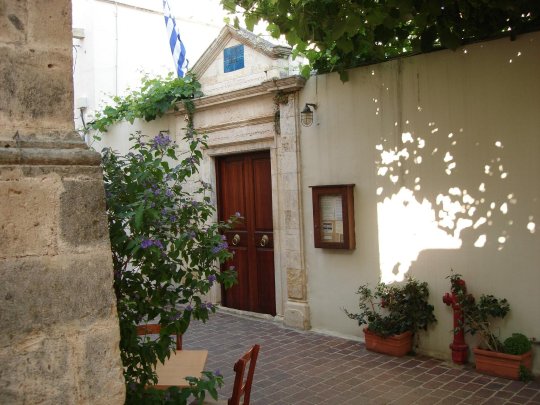
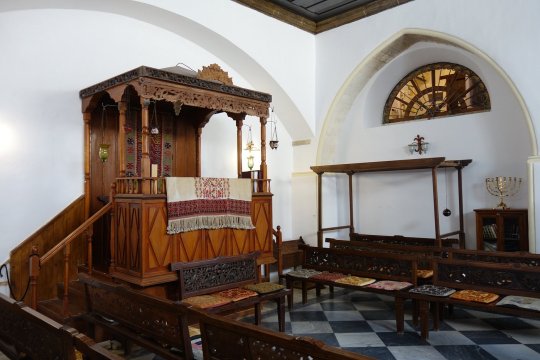
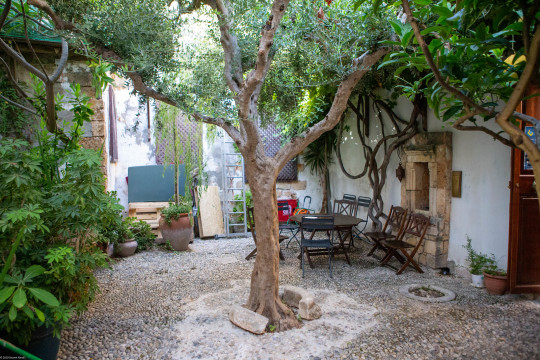
etz hayyim (“tree of life”) synagogue in chania, crete, greece. the building dates to the 14th-15th centuries, and was originally a venetian catholic church. it was acquired by chania's jewish community and converted into a synagogue in the late 17th century. chania's jews were deported due to the holocaust in 1944, after which the building remained abandoned until restoration in the 1990s.
romaniote jews are the oldest jewish community in europe and one of the oldest in the world, thought to have lived in and around present day greece since before 70 ce. they have their own liturgy that is unrelated to the more commonly used european ones (ashkenazic and sephardic).
#greece#architecture#interior#worship#jewish#romaniote#old & new#my posts#for all u Westerners 'rom' = constantinople referring to itself as the roman empire#so rome/italy is like 'west roman' constantinople/greece/anatolia is like 'east roman'#in the west its called 'byzantine' from 'byzantium' (proto-constantinople)#also it insinuates w roman empire was the 'real' roman empire (despite east lasting 1000 years longer)#in most mediterranean & w asian languages greece/greek is 'yunan/yawan/yavan' (from ionians) or 'rum/rom' (from roman)#in actual greek it's 'hellas'/'ellas' (from hellenic)#in georgian it's 'saberdzneti' for some reason but they also have their own names for a bunch of places#'greece' comes from the latin name 'graecia'#in a lot of slavic languages it's some variation of 'greece'. weird considering most were never/hardly under latin influence#if you think this is a lot just wait until u hear about the all the names for armenia#but yeah these guys were also in a lot of the balkans. if you're from the balkans and jewish you MAY have romaniote ancestry#(at least more recent romaniote ancestry than all other european jews)#not a guarantee though especially if you're ashkenazi#theres like. other jewish groups in europe that predated ashkenazi migration#most of them just got absorbed into the ashkenazi population
415 notes
·
View notes
Text
Anyway as much as I do appreciate westerners taking an interest in Chinese culture it sometimes feels like my culture is just viewed as an art piece. Chinese people and culture are not artworks on display for western viewers’ pleasure. We are very real people, with very real culture, and as someone who has been overseas and removed from my culture for a good portion of my life it sometimes hurts when CN culture is just viewed as surface level “pretty” or heaven forbid “aesthetic,” when it’s so much more than that.
#like!!! hanfu & calligraphy and Chinese architecture are undeniably very pretty!!!#it’s just… we get treated with so much exoticism and orientalists#I spent so many years being called ‘exotic’ as like. a compliment.#that when I see that same kind of sentiment it makes me very uncomfy#I get that Chinese culture is foreign to westerners but it’s not always about you#there can be appreciation without orientalism#so treat Chinese fashion on the same level as western fashion#and other arts too!#hanfu is to me like corsetry and petticoats are to my fully western-raised partner#things like comparing and contrasting styles and techniques from an equal standpoint is super neat too!#and like. treating art as art is one thing but when the entire culture and even the people themselves get wrapped up into that ‘art’#it’s a little bit messed up tbh
44 notes
·
View notes
Text
Dungeon meshi has wonderful and thought out world building but the inherent creator bias still shows through sometimes in small funny ways
#dungeon meshi#ep 1#why are they eating with chopsticks when the island is mostly western in architecture/culture etc#hahaha#i always think its so funny even in like medieval isekais/webtoons#when everyone has european names#castles#dresses etc#but their school system is japanese or their meals etc#like the small stuff the author thinks is normal#calling the duke 'hyung' when there is absolutely no way that would happened at that time#its a bit endearing#i read a brothers grimm/fairy tale inspired manga#and the protag is a grimm brother who befriends hans christian andersen and subsequently calls him “an-chan”#western media has that a lot too#people eating with forks when they would use chopsticks#having meals with beef in them when its a terrain where cows wouldnt live and chicken or goat or fish would make more sense#eastern media aallllwaaysss including an age based honorifics system#western media often modeling religion along the abrahamic faiths#etc
26 notes
·
View notes
Text
Watching the new Percy Jackson episode, and while by no means is the show perfect, I do love how they updated the blending of Greek mythology and the American Gothic for social commentary.
What I mean is Echidna, the mother of monsters, is some respectable-looking vaguely southern white woman who is able to convince the police on the train that three kids shattered a train window and used those institutions to isolate the kids so she can target them and scare them for the chimera's hunt. The way that the police especially treat Annabeth. Now, as a young black girl, she has to know how to ask if they're getting arrested, and gets called out by the police for her tone.
And then, at the St. Louis Arch, we see Grover upset because of the museum, which is basically a monument to Manifest Destiny (literally, there's a shot where the words are in full display in the background). And while they say, "Grover is upset because he doesn't like it when people hurt animals," they explicitly depict America's colonization and destruction of indigenous communities as The Bad Thing. It adds another layer of flavor for the whole "Pan is missing" - it's not just about Climate Change. It's about the extermination of indigenous groups (the centaurs they saw on the train, the reminder that there used to be more of them until humans started killing them). They say "humans" are bad, but they're showing us Western/American colonizers.
Also, a rare yet interesting moment of conflict between Annabeth as a daughter of Athena and Grover as a Satyr. Annabeth insists that the museum's commodifying and glorifying of American colonization is "not what the arch is actually about, it's about architecture and math," but Athena is the goddess who protects social institutions and a patron goddess of the state, law, order, industry, and war. The Industrial Revolution and Western social institutions definitely contributed to colonialism; just saying. We also see in this episode that Athena can be arrogant and cruel - letting a monster go after her own daughter because she was embarrassed.
Anyway, idk. Maybe I'm overthinking this but these were the things that popped out to me on first watch, and now that I think about them more, I would love a continuation of these kinds of themes and tropes in future seasons, if we get them.
#percy jackson#percy jackon and the olympians#percy jackson series#pjo series#pjo tv show#disney pjo#percy jackson spoilers
6K notes
·
View notes
Text
April 13, Xi'an, China, Shaanxi Archaeology Museum/陕西考古博物馆 (Part 4 - Sui and Tang dynasties):
This is another star of the museum, a Tang dynasty (618 - 907 AD) bronze mirror, the back of which is decorated with carved luodian/螺钿 (mother of pearl). Near the edge are various birds, while the inner ring is arranged in a "sunflower" shape. Kinda wish I can see a modern replica of this one without all these marks and discolorations from the passage of time:
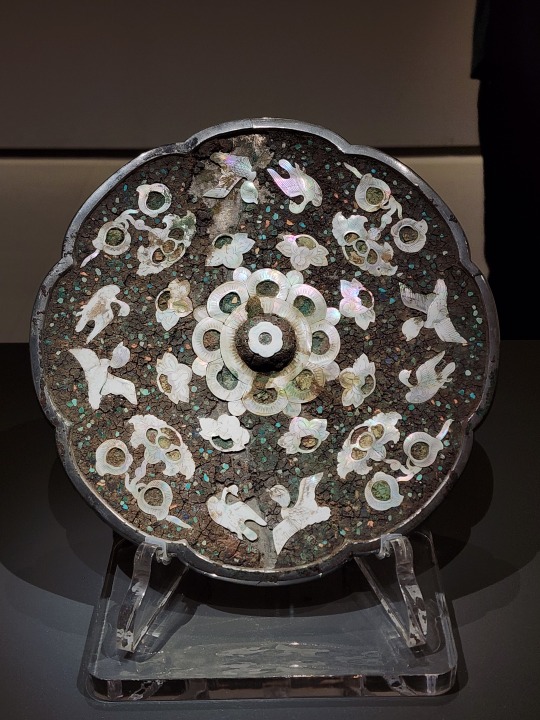
A Tang dynasty yupei/玉佩 (jade pendant). Unlike the Western Zhou dynasty yupei in part 2, this type is most definitely supposed to be hung from the waist. This one in particular was one of a set of two (both worn on waist, one on each side), and these were part of the formal wear of first to fifth rank officials during Tang dynasty:

Luo Wanshun's Epitaph/罗婉顺墓志. As mentioned in the first Beilin museum post, ancient Chinese epitaphs have a two-piece structure, consisting of a tablet and the protective covering on top. This is the protective covering on top, with the large inscription identifying this as the epitaph stone of Luo Wanshun, engraved in seal script/zhuanshu/篆书:
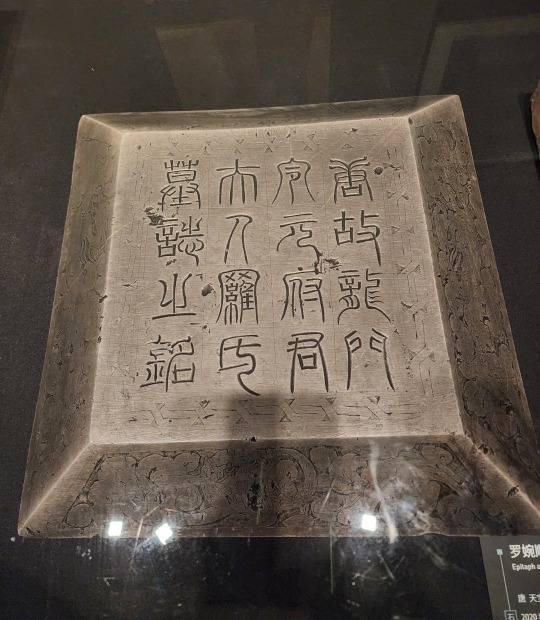
And here's the actual body of the epitaph. This particular epitaph was drafted by one of the "Eight Immortals of the Wine Cup"/饮中八仙, Li Jin/李琎 (he was also the nephew of Emperor Xuanzong of Tang/唐玄宗), and the calligraphy was provided by the famous calligrapher Yan Zhenqing/颜真卿:
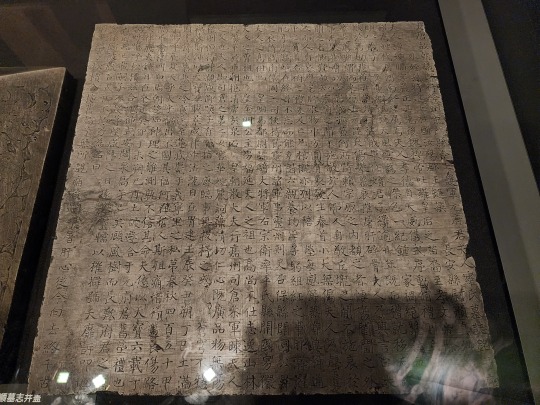
Tang-era pottery figurines of the Chinese zodiac animals. This set is sadly incomplete, but the way these zodiac animals are partially anthropomorphized is pretty interesting. From left to right, these are tiger, rabbit, dragon, snake, sheep, and dog (yep that is a dog head, apparently). Not sure why rabbit and dog figurines are missing their ears though, maybe the ears broke off and are lost?
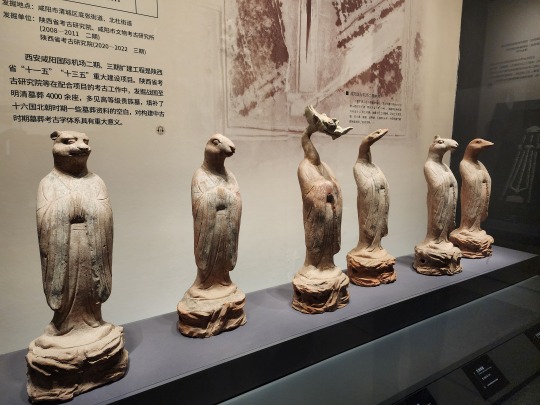
Sui dynasty (581 - 618 AD) green-glazed boshanlu/博山炉 incense burner. Note the panlong/蟠龙 dragon curled around the base:
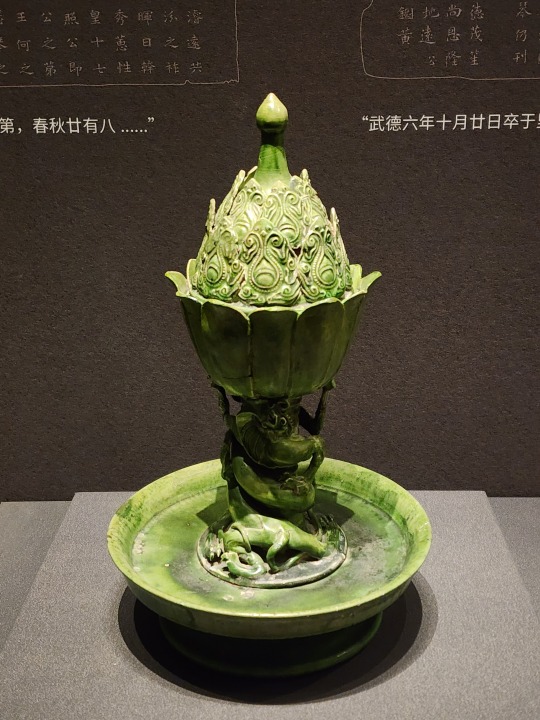
Left: Sui dynasty white-glazed ewer with a chicken head-shaped handle. Right: Sui dynasty white-glazed vase. The curves on this one is *chef kiss*
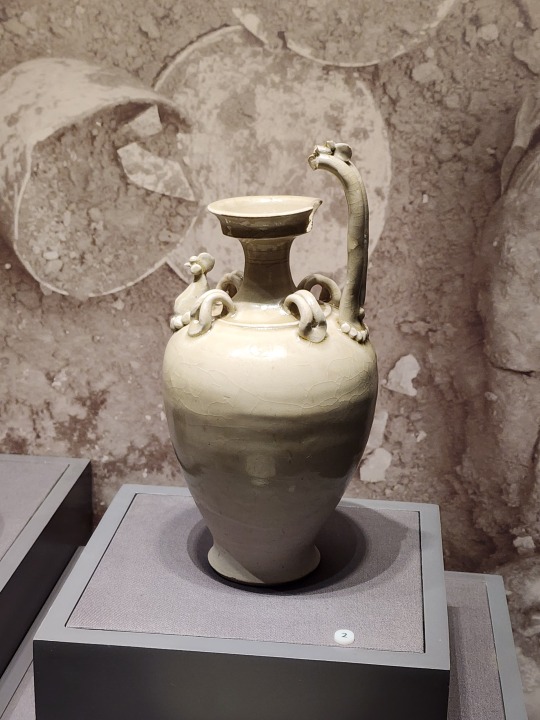
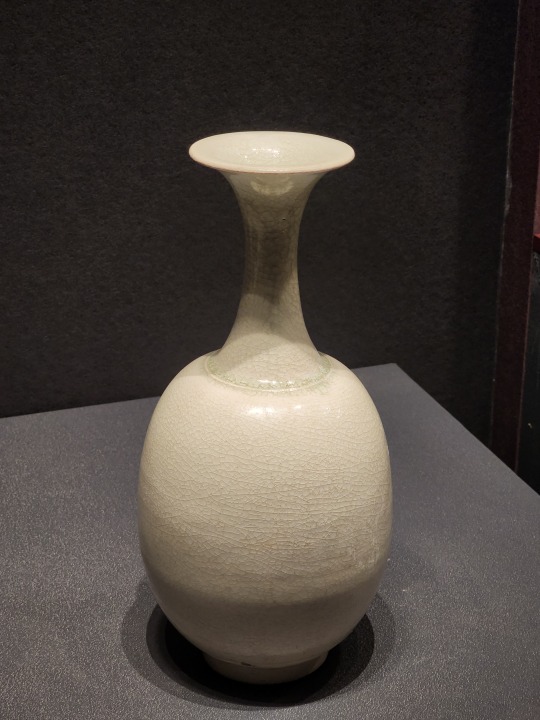
More Sui dynasty white glazed pottery, but the most incredible thing is the white porcelain cup in the middle. The lip of that cup is 1mm (~1/32 in) thick, and the sides are so thin, it's almost see through:
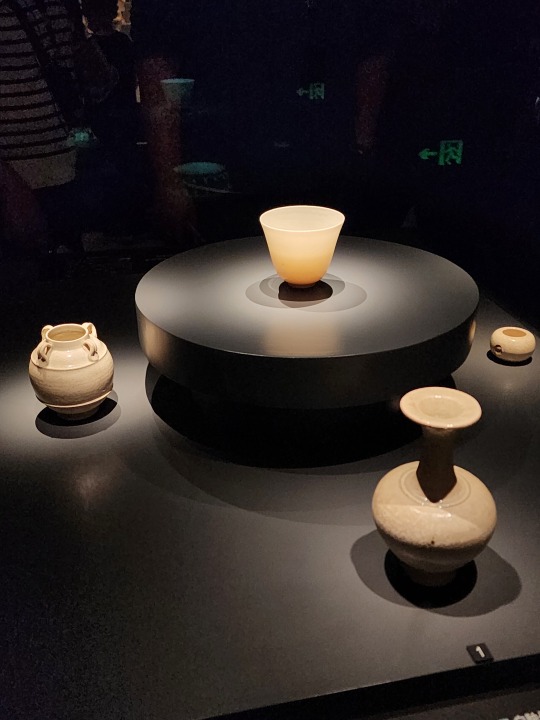
Tang-era sancai/三彩 glazed conjoined flasks that is shaped like a pair of fish. Similar twin-fish motif can be found in numerous traditional Chinese holiday decor, and symbolize auspiciousness, wealth, and surplus--especially surplus, since fish in Chinese (鱼) is pronounced yú, and "surplus" in Chinese (余) is also pronounced yú. This is why the phrase 年年有余 ("may there be a surplus every year") is often paired up with imagery of carps, children holding giant carps, or a twin-fish motif.
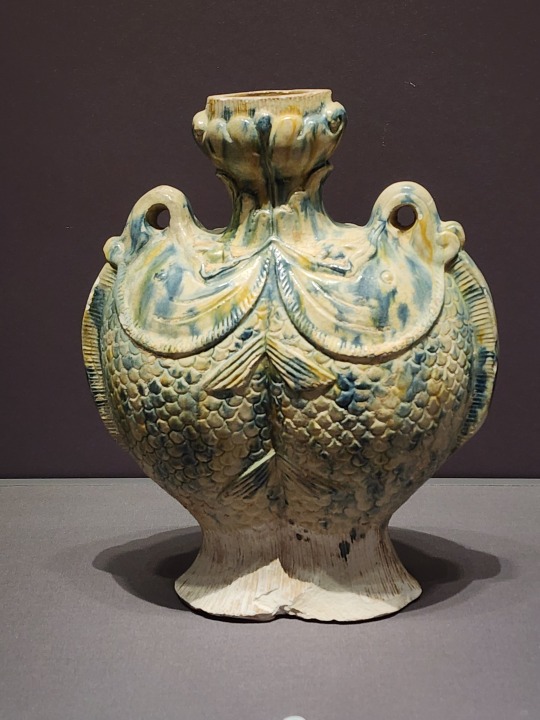
Absolutely beautiful Tang-era wall mural of a tiger, which was very sadly damaged over time. But from the pieces left, you can still appreciate the raw power of the tiger captured by these lines:
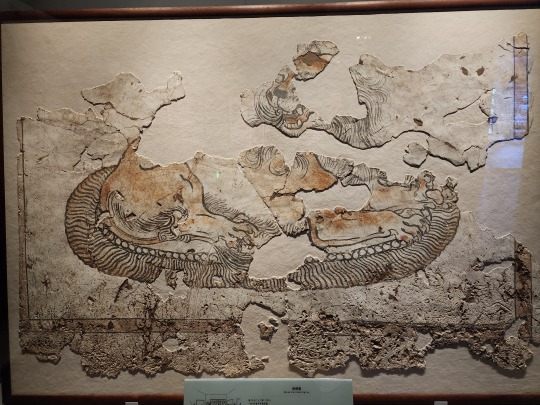
Another beautiful Tang-era wall mural depicting men on horseback playing "polo", called maqiu/马球 (lit. "horse ball") in Chinese. It's unclear whether the maqiu depicted here originated in China in late Eastern Han dynasty (25 - 220 AD) or was brought to China via the Silk Road at the beginning of Tang dynasty, but anyway this sport was very popular during Tang dynasty, and there were many female players at the time too.

The women of Tang dynasty as depicted by pottery figurines:


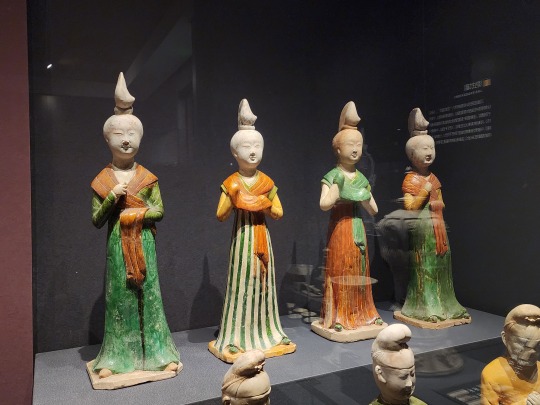
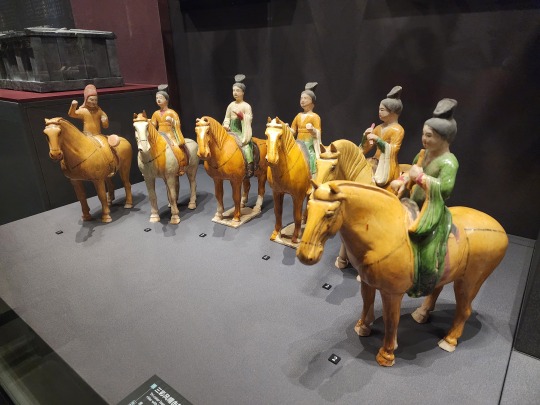
A small model of Tang-era triple que/阙 gate towers. Que gate towers first appeared in Western Zhou dynasty (1046 - 771 BC) and have been a part of Chinese architecture ever since. Que gate towers usually come in pairs, one on each side of the gate, and they were used to display status.
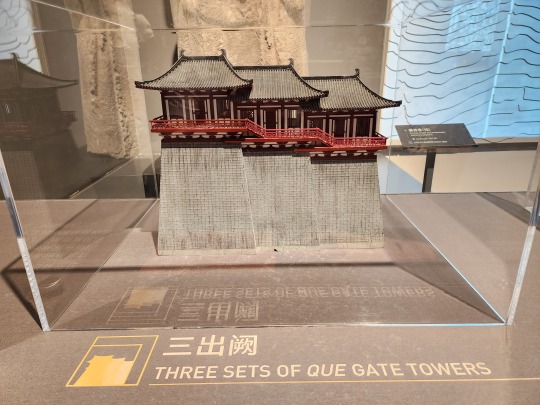
A map of Tang dynasty Chang'an city laid on top of the current map of Xi'an city, showing the imperial palace (top center), the East Market/东市 and West Market/西市, and the 108 districts (called fang/坊):
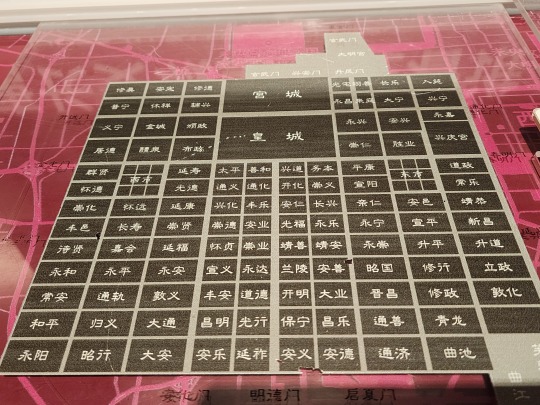
A Tang-era chiwen/鸱吻 (螭吻 is the original name, 鸱吻 is the alternative name, another alternative name is 蚩吻, but the pronunciation remains the same for all three) roof ornament. These are the pairs of horn-shaped pieces on the top of the roof of traditional Chinese architecture. These ornaments are made to represent the Ninth Son of the Dragon, called Chiwen/螭吻, which looks like a dragon-headed fish and has the power to control water, thus it's used in traditional Chinese architecture to ward off fires:
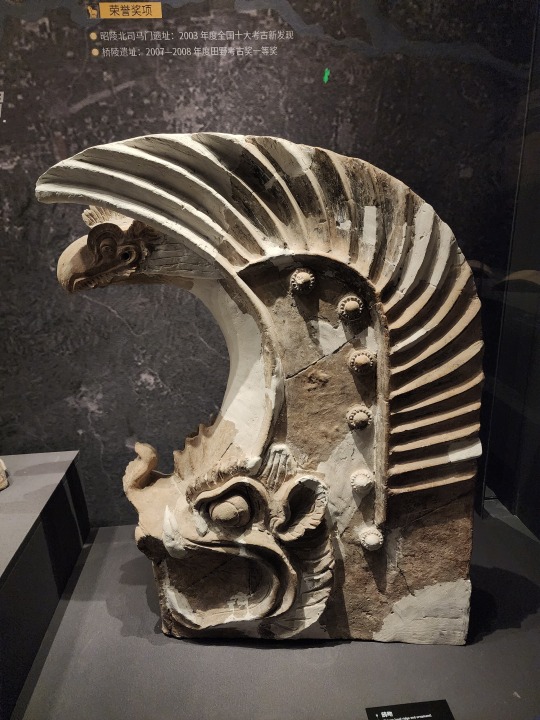
Sui-era gold gilded handle of a stone sarcophagus:
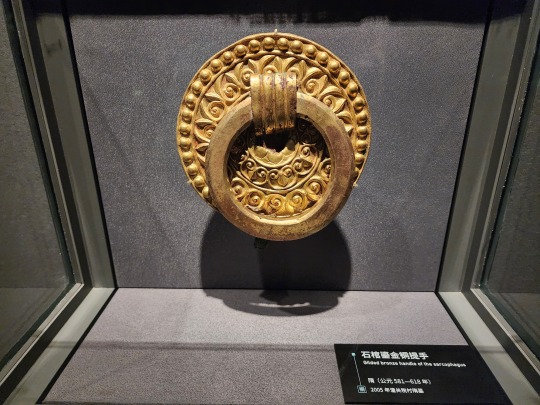
A pottery jar found buried in the tomb of Crown Prince Jiemin/节愍太子 (Li Chongjun/李重俊, son of Emperor Zhongzong of Tang/唐中宗 Li Xian/李显), partially shaped like a pagoda and decorated with various Buddhist motifs such as lotus petals and elephant heads. This is speculated to be a representation of a granary, which would hold grains for the crown prince in the afterlife:
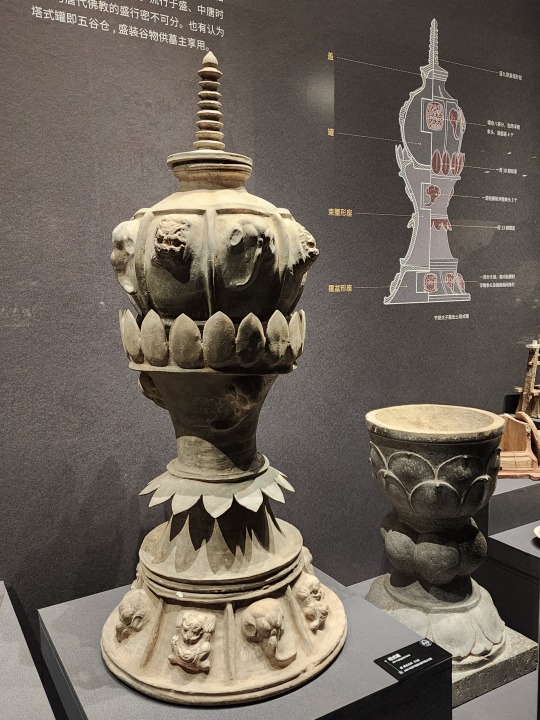
And last but not least, a Sui-era pottery camel bearing sacks that have the imagery of the Greek god of wine Dionysus upon them, which shows the great amount of cultural exchange that took place back then:
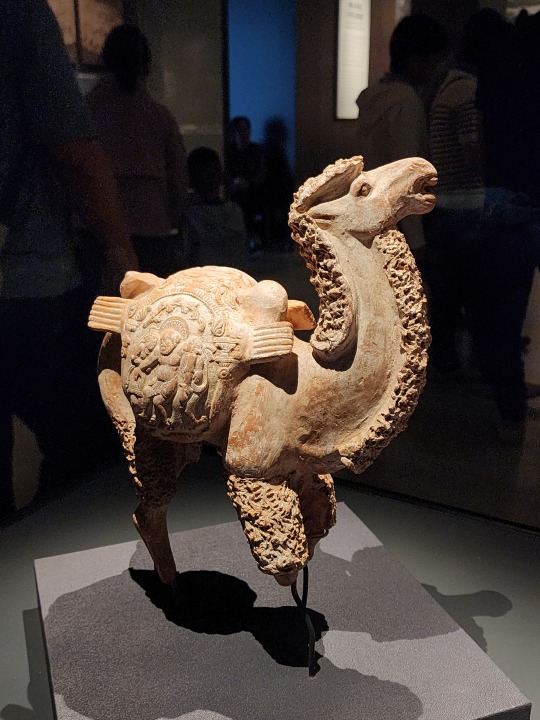
#2024 china#xi'an#china#shaanxi archaeology museum#chinese history#chinese culture#sui dynasty#tang dynasty#chinese calligraphy#calligraphy#archaeology#history#culture
235 notes
·
View notes
Text
So I’ve been thinking about cultural Christianity lately and how people tend to get very upset about it without really understanding what it is, so here is a primer
Cultural Christianity is not a choice you make. It does not mean you are Christian, or even that you remotely like Christianity; a lot of people who vehemently hate the religion do so because of their own cultural Christianity
It is not a shortcoming, or a moral failing, or a sin. It just means that the culture you were raised in was predominantly Christian.
Note: I did not say “majority Christian”. Christians don’t need to be a majority to have a dominant cultural influence
Cultural Christianity means you inherently understand and probably use swearwords like “damn”, “hell”, or a variation on the name “Jesus Christ”
It means when I say cultural Christianity is not a sin, you understand exactly what I mean without needing to have it explained - and you probably know the phrase “original sin” or “seven deadly sins”, even if not in full detail
It means hearing about Hades, god of the dead, wealth, and volcanoes, and assuming he’s the bad guy of Greek mythology… y’know, like Satan
(EVERYONE went to Hades when they died. The Elysian Fields, where the best heroes went, was in Hades’ underworld. The Eleusinian mysteries, a cult to Demeter and Persephone, was basically about asking them to tell Hades to give you a cool afterlife
And he would cuz he drank his “respect wife” juice if not all of his “respect women” juice. Did still kidnap her. But she is a major feature and often makes the decision herself or influences his when they’re mentioned together
Meanwhile, people try and cast Zeus as a good parent)
It means having to have a dreidel, a menorah, or a kinara explained to you at a time when you already knew about Christmas trees and Santa
(Yes, Santa Claus, Saint Nicholas, major host of the Mass of Christ, is culturally Christian. Even though Coke invented his aesthetic - that’s the “cultural” part)
It’s when you go to make up a new non-religious or pan religious winter celebration… that is centred around a day with family and gifts which is obviously the 25 of December. Maybe counting down 12 days before
It’s defaulting to calling a place of worship you don’t know the name of a “church”
Cultural Christianity is not something people have a choice in; you don’t pick where you’re born, and there are so many other cultures in places like Canada, America, and Britain that are culturally Christian out the ass! But… you will catch Contact Christianity in any of these places
It’s damn near impossible to consume any American or most Western media without brushing across it; cross imagery is everywhere, Christian demons and devils sneak into media all around the world
Western (and some other) Gothic fashion leans heavily on gothic architecture and, yeah, heavily Catholic imagery
Now, brushing across the media in other parts of the world does not impart the same level of cultural Christianity as growing up in a city with four churches on a single block and a Santa Claus parade
And you can grow up heavily in an entirely different culture even in the Bible Belt (but you know what Bible Belt means); you don’t have to abandon all other culture just because Christianity has a chokehold on your home
But when December (or fucking November these days) hits and you hear Mariah Carey in 3/6 stores, yes, you probably have some cultural Christianity
You sure as hell don’t need to be able to name half the denominations (can you name more than 4?), you may never set foot in a Christian church in your life, and still have a cultural Christian influence
If your street names have “saint” in them
If there are crosses or angels on more than half the graves in a cemetery
If you know how to cross yourself but aren’t really sure when you learned; you didn’t look it up or do research to find out
Now note: none of these have an inherent moral judgement attached to them
It’s just about what the culture you live in has taught you about the world, and there’s no culture that is magically the Right One or better than the others
There’s no reason to expect even specifically Christian culture to be the same around the world; it isn’t. It has the same root, but what flowers from the soil is another matter entirely
There is nothing wrong with acknowledging that you have culturally Christian influences and biases; being human is 90% absorbing information from the world around us and half processing it at best - there’s just too much input, and intentionally filtering out Everything Christian Ever?
Well unless you started at 2 years old, odds are pretty good it’s not really a personal choice kinda thing
And you cannot compensate for these influences unless you acknowledge that they exist, that you did not choose to form them, and that you do get to choose how they affect your actions going forward
Christmas stuffed a bunch of other religious traditions into a single package to make itself popular, but if you learned them as Christmas traditions first… do I even need to say it?
#cultural christianity#especially at this time of the year#it just bothers me when people try and deny it#like they’re ‘too good’ to be formed by the society they grew up in#no friend#your deadass brain formation is affected by your first language
357 notes
·
View notes
Text
Ukraine’s President Zelenskyy presented his Victory Plan at the Verkhovna Rada on October 16, stressing the end of the war depends on Ukraine’s partners and not on Russia’s leader Vladimir Putin.
The Victory Plan consists of 5 points and 3 secret subpoints.
"If the plan is supported, we can end the war no later than next year," Zelenskyy said. "If we and our partners don't strengthen now, Putin will significantly strengthen next year.”
The President emphasized that Moscow is not interested in peace.
"Russia isn’t seeking an honest peace. Putin only wants war. We must change the circumstances so the war ends regardless of what Putin wants," Zelenskyy said.
The key points from President Zelenskyy’s address are as follows:
Invitation of Ukraine to NATO: Zelenskyy emphasized that Ukraine's invitation to NATO would serve as a "proof of determination" and signal how NATO partners envision Ukraine’s role in the future "security architecture."
Strengthening Defense: This point includes operations in strategic locations to prevent the creation of buffer zones within Ukraine, enhanced anti-aircraft defenses, joint efforts with partners to shoot down Russian aircraft, expanding the use of Ukrainian drones and missiles, removing restrictions on the use of weapons, and providing access to partner intelligence.
Deterrence: Zelenskyy called for the deployment of a comprehensive non-nuclear deterrence package aimed at protecting Ukraine from Russian aggression and limiting Russia's capabilities.
Development of Strategic and Economic Potential: Zelenskyy also highlighted the need to strengthen Ukraine’s strategic and economic potential, as well as intensify sanctions against Russia.
Post-War Contribution to NATO: After the war, the Ukrainian military could apply its experience to bolster NATO and European defense efforts. The President also suggested that Ukrainian forces could eventually replace the U.S. contingent in certain areas.
According to Zelenskyy, the second, third, and fourth points have secret sub-points that are revealed to the US and certain EU countries, including Britain and Italy.
Zelenskyy had planned to unveil his Victory Plan to Ukraine's Western allies during the Ukraine Defense Contact Group meeting at Germany's Ramstein airbase on October 12. However, the gathering was canceled after US President Joe Biden postponed his overseas travel due to Hurricane Milton.
58 notes
·
View notes
Text


Asked about the high points of architecture in the former GDR many will probably name the demolished Palast der Republik in Berlin or maybe Ulrich Müther's delicate shell constructions. A smaller but no less exciting example is the so-called Glashaus (1974-78) located in the Volkspark in Jena, a highly unusual building in which architect Friedhelm Schubring channeled influences from Richard Neutra and Mies van der Rohe. At this point one might wonder how a building with such obvious references to western architecture could be realized under the GDR’s tight architectural doctrines. The answer to this anomaly in the GDR’s architectural history is the fact that it was deemed insignificant: a small building designed as part of the Volkspark’s redevelopment to house different functions didn’t bring the architectural ideologists on the scene. The only struggles Schubring had to wage were with some of the craftsmen who at first opposed some of the architect’s detail solutions, especially with regard to the large windows and their adhesive joints. Ultimately Schubring’s insistence paid off: the Glashaus due to its Neutra-esque Spider Legs and the Miesian wall slabs stands as a unique example of architecture in the GDR beyond all doctrines.
In time for the 50th anniversary of the architect’s planning application the sponsoring association „Glashaus im Paradies e.V.“ recently published the small catalogue „Das Glashaus - Zeitlos modern“ in an edition of 200 copies. The catalogue contains a retrospective of the association’s manifold activities and exhibitions that took place in the Glashaus but also a comprehensive overview of the building’s history. The latter actually is rather sad since it was never properly used and in later years became a storage space for Jena’s city administration. Fortunately „Glashaus im Paradies e.V.“ in 2005 attended to the Glashaus, initiated its authentic renovation and finally used it for a multitude of cultural events and exhibitions.
The building’s outstanding architecture also appears in the numerous drawings and photographs included in the catalogue. They are supplemented with quotes by the architect and an insightful essay by conservator Heribert Sutter who discusses the history and constructive details of the Glashaus and why it is so special. Simply a great read!
36 notes
·
View notes
Note
Yo, I saw your post about orientalism in relation to the "hollywood middle-east" tiktok!
How can a rando and university dropout get into and learn more about? Any literature or other content to recommend?
Hi!! Wow, you have no idea how you just pressed a button. I'll unleash 5+ years on you. And I'll even add for you open-sourced works that you can access as much as I can!
1. Videos
I often find this is the best medium nowadays to learn anything! I'll share with you some of the best that deal with the topic in different frames
• This is a video of Edward Said talking about his book, Orientalism. Said is the Palestinian- American critic who first introduced the term Orientalism, and is the father of postcolonial studies as a critical literary theory. In this book, you’ll find an in-depth analysis of the concept and a deconstruction of western stereotypes. It’s very simple and he explains everything in a very easy manner.
• How Islam Saved Western Civilization. A more than brilliant lecture by Professor Roy Casagranda. This, in my opinion, is one of the best lectures that gives credit to this great civilization, and takes you on a journey to understand where did it all start from.
• What’s better than a well-researched, general overview Crash Course about Islam by John Green? This is not necessarily on orientalism but for people to know more about the fundamental basis of Islam and its pillars. I love the whole playlist that they have done about the religion, so definitely refer to it if you're looking to understand more about the historical background! Also, I can’t possibly mention this Crash Course series without mentioning ... ↓
• The Medieval Islamicate World. Arguably my favourite CC video of all times. Hank Green gives you a great thorough depiction of the Islamic civilization when it rose. He also discusses the scientific and literary advancements that happened in that age, which most people have no clue about! And honestly, just his excitement while explaining the astrolabe. These two truly enlightened so many people with the videos they've made. Thanks, @sizzlingsandwichperfection-blog
2. Documentaries
• This is an AMAZING documentary called Reel Bad Arabs: How Hollywood Villifies A People by the genius American media critic Jack Shaheen. He literally analysed more than 1000 movies and handpicked some to showcase the terribly false stereotypes in western depiction of Arab/Muslim cultures. It's the best way to go into the subject, because you'll find him analysing works you're familiar with like Aladdin and all sorts.
• Spain’s Islamic Legacy. I cannot let this opportunity go to waste since one of my main scopes is studying feminist Andalusian history. There are literal gems to be known about this period of time, when religious coexistence is documented to have actually existed. This documentary offers a needed break from eurocentric perspectives, a great bird-view of the Islamic civilization in Europe and its remaining legacy (that western history tries so hard to erase).
• When the Moors Ruled in Europe. This is one of the richest documentaries that covers most of the veiled history of Al-Andalus (Muslim Spain). Bettany Hughes discusses some of the prominent rulers, the brilliance of architecture in the Arab Muslim world, their originality and contributions to poetry and music, their innovative inventions and scientific development, and lastly, La Reconquista; the eventual fall and erasure of this grand civilization by western rulers.
3. Books
• Rethinking Orientalism by Reina Lewis. Lewis brilliantly breaks the prevailing stereotype of the “Harem”, yk, this stupid thought westerns projected about arab women being shut inside one room, not allowed to go anywhere from it, enslaved and without liberty, just left there for the sexual desires of the male figures, subjugated and silenced. It's a great read because it also takes the account of five different women living in the middle east.
• Nocturnal Poetics by Ferial Ghazoul. A great comparative text to understand the influence and outreach of The Thousand and One Nights. She applies a modern critical methodology to explore this classic literary masterpiece.
• The Question of Palestine by Edward Said. Since it's absolutely relevant, this is a great book if you're looking to understand more about the Palestinian situation and a great way to actually see the perspective of Palestinians themselves, not what we think they think.
• Arab-American Women's Writing and Performance by S.S. Sabry. One of my favourite feminist dealings with the idea of the orient and how western depictions demeaned arab women by objectifying them and degrading them to objects of sexual desire, like Scheherazade's characterization: how she was made into a sensual seducer, but not the literate, brilliantly smart woman of wisdom she was in the eastern retellings. The book also discusses the idea of identity and people who live on the hyphen (between two cultures), which is a very crucial aspect to understand arabs who are born/living in western countries.
• The Story of the Moors in Spain by Stanley Lane-Poole. This is a great book if you're trying to understand the influence of Islamic culture on Europe. It debunks this idea that Muslims are senseless, barbaric people who needed "civilizing" and instead showcases their brilliant civilization that was much advanced than any of Europe in the time Europe was labelled by the Dark Ages. (btw, did you know that arabic was the language of knowledge at that time? Because anyone who was looking to study advanced sciences, maths, philosophy, astronomy etc, had to know arabic because arabic-speaking countries were the center of knowledge and scientific advancements. Insane, right!)
• Convivencia and Medieval Spain. This is a collection of essays that delve further into the idea of “Convivencia”, which is what we call for religious coexistence. There's one essay in particular that's great called Were Women Part of Convivencia? which debunks all false western stereotypical images of women being less in Islamic belief. It also highlights how arab women have always been extremely cultured and literate. (They practiced medicine, studied their desired subjects, were writers of poetry and prose when women in Europe couldn't even keep their surnames when they married.)
4. Novels / Epistolaries
• Granada by Radwa Ashour. This is one of my favourite novels of all time, because Ashour brilliantly showcases Andalusian history and documents the injustices and massacres that happened to Muslims then. It covers the cultural erasure of Granada, and is also a story of human connection and beautiful family dynamics that utterly touches your soul.
• Dreams of Trespass by Fatema Mernissi. This is wonderful short read written in autobiographical form. It deconstructs the idea of the Harem in a postcolonial feminist lens of the French colonization of Morocco.
• Scheherazade Goes West by Mernissi. Mernissi brilliantly showcases the sexualisation of female figures by western depictions. It's very telling, really, and a very important reference to understand how the west often depicts middle-eastern women by boxing them into either the erotic, sensual beings or the oppressed, black-veiled beings. It helps you understand the actual real image of arab women out there (who are not just muslims btw; christian, jew, atheist, etc women do exist, and they do count).
• Letters of Lady Mary Wortley Montagu. This is a feminist travel epistolary of a British woman which covers the misconceptions that western people, (specifically male travelers) had recorded and transmitted about the religion, traditions and treatment of women in Constantinople, Turkey. It is also a very insightful sapphic text that explores her own engagement with women there, which debunks the idea that there are no queer people in the middle east.
---------------------
With all of these, you'll get an insight about the real arab / islamic world. Not the one of fanaticism and barbarity that is often mediated, but the actual one that is based on the fundamental essences of peace, love, and acceptance.
#orientalism#literature#arab#middle east#islam#feminism#book recommendations#reference#documentary#western stereotypes#eurocentrism#queer#queer studies#gender studies#women studies#cultural studies#history#christianity#judaism#books#regulusrules recs#If you need more recs#or can’t access certain references#feel free to message me and I’ll help you out!#regulusrules answers
116 notes
·
View notes
Text
Palestinian liberation is a feminist issue. While this truism should need no elaboration, it has, as with so much that relates to Palestine, necessitated discussions, clarifications, analysis and documentation, again and again. Palestine rights activists have long been familiar with the all too common phenomenon known as PEP: Progressive Except for Palestine. Less known, but no less common in feminist circles is FEP, the Feminist Except for Palestine phenomenon. Books such as Evelyn Shakir’s 1997 Bint Arab recount incidents of FEP going back to the ’60s, with many Arab feminists being shunned by their American friends over their support for Palestinian liberation. FEP had one of its early expressions on a global stage at the 1985 United Nations World Conference on Women in Nairobi, Kenya, when Betty Friedan, an icon of second‑wave western feminism, with its slogan ‘the personal is political’, tried to censor the late Egyptian feminist Nawal el‑Saadawi as she was about to walk up to the stage to deliver her address. ‘Please do not bring up Palestine in your speech,’ Friedan told el‑Saadawi. ‘This is a women’s conference, not a political conference.’ Sadly, little has changed in global north feminism’s rejection of the very humanity of the Palestinian people, as evidenced in their continued exclusion from national and global discussions of women’s issues. White feminism has continued to align itself with orientalist imperialist militarism; Ms Magazine cheered the Bush Administration’s US war on Afghanistan in 2001, calling it a ‘coalition of hope’, and suggesting that invasion and occupation could, indeed would, liberate Afghan women. The white feminists in the Feminist Majority Foundation, which bought Ms Magazine in December 2001, never consulted with Afghan feminist organisations such as the Revolutionary Association of the Women of Afghanistan, who denounced both religious fundamentalism and western intervention in Afghanistan, and who opposed the US attacks on their country. More recently, hegemonic feminism’s desire to exempt Israel from criticism led to the fragmentation of the Women’s March, the coalition of women’s and feminist groups that came together to denounce the election of Donald Trump to the presidency of the US. The co‑chair of the 2017 Women’s March was Brooklyn‑born Palestinian American Linda Sarsour, a grassroots organiser who had long championed Palestinian rights. When journalist Emily Shire asked in the New York Times ‘Does Feminism Have Room for Zionists?’, Sarsour responded with a resounding ‘No’. Many felt threatened by her outspokenness and visibility. Another Palestinian feminist, Mariam Barghouti, also asserted in a 2017 article that ‘No, You Can’t Be a Feminist and a Zionist’, and explained that: ‘When I hear anyone championing Zionism while also identifying as a feminist, my mind turns to images of night raids, to the torture of children and to the bulldozing of homes.’ In the wake of Israel’s latest war on Gaza, white feminists are denouncing the unsubstantiated accusations of sexual violence against Israeli women, without addressing the Israeli state’s amply documented gendered violence against Palestinian women, children, and men. ‘Feminism cannot be selective. Its framework comes from true and absolute liberation not just of women, but of all peoples,’ Barghouti continues, building on bell hooks’ analysis of feminism as a complete liberatory movement. ‘A feminist who is not also anti‑colonial, anti‑racist and in opposition to the various forms of injustice is selectively and oppressively serving the interests of a single segment of the global community.’ Simply, ‘feminism’ that aligns with regimes that engage in racial and ethnic oppression is gendered supremacy; no ideology that hinges on supremacy and discrimination is reconcilable with feminism.
94 notes
·
View notes
Note
Submitting my thoughts as an Indian and Pakistani fan of GG, but I'm kinda disappointed that a lot of analysts who cover Zepp don't seem all too concerned with looking closely at aspects of South Asian culture and history or anything outside of India when it comes to Zepp. Yes it is Indian but you can't discuss India and just magically divorce it from shared cultural ties with Pakistan (and by extension Bangladesh, however I am not Bengali and thus can't speak much on it.) For example Gabriel's blue uniform is so clearly based on a veshti combined with the female air force uniform for Pakistan, or that Zepp's symbol is based on the Garuda Commando Forces logo- even the uniforms of said force match much closer to Zepp's uniforms than any stated "inspiration" I've seen. Hell even the slavery system within Zepp is a reflection that our countries still struggle with caste and class based slavery on a much larger scale (it's affected my own lower class family). This isn't even to mention Potemkin who seems much more tied to how Indo-Pak militarism, nationalism, and facism can affect areas like Kashmir. People are quick to call "German and Russian" influences but the only ones I remotely even observe as a brown person are literally just Pot and Gabriel's names. I dunno. It's just vexing to me. Like it's a country made by dissatisfied Indians post-crusades, so the idea that the old government was somehow less south asian is like. Weird to me. Like there's nothing to indicate that other than people conflating out architectural styles with Russian ones too. Like a lot of Zepp seems to resemble Rajasthani and Punjabi (both sides) architecture in particular but I'm just saddened knowing nobody will look that far into it simply because they might not have that same cultural attachment to it.
Side note I'm also not a fan of how Daisuke refuses to give names to Zeppian characters that match with their ethnic background. For every Leon Mining, Gabriel, and Potemkin, we could've gotten like... actual references to our rock and metal scene. Even "Zepp" as the country name dissatisfies me. Creators and fandoms have such a bad habit at making something or acknowledging something as "South Asian" and then refuse to elaborate on it beyond a few visuals. It feels gauche.
Something something the prevalence of ki not being touched upon for any of South Asia / Zepp by extension within GG is also a major annoyance when we share a lot of faith based aspects with regions like China and Japan.
This has been kinda long winded but holy shit fighting games really just annoy me sometimes with how they treat South Asia as a whole. I just feel it very strongly with GG in particular since Daisuke was very close to peak. So close. I will say he clearly put in a lot of effort that non-south asians probably wouldn't recognize at a first glance, but the smaller details surrounding Zepp and some of the assumptions made about Zepp fandom wise combine into a "nobody will get it like I do" situation.
It's genuinely very cool to see someone's perspective and analysis on it who has more experience and understanding than most western gamers. I appreciate you sharing!
95 notes
·
View notes
Text
The ancient Beanbean Kingdom

The Beanbean Kingdom is a kingdom that features in Mario & Luigi: Superstar Saga and its remake for the 3DS, being located directly south of the Mushroom Kingdom. In the game, several hints are given as to the ancient past of this kingdom through the mentions of ancient civilizations, which I want to document in this post.
The Hoohoo Civilization
One of the first areas Mario and Luigi visit in the Beanbean Kingdom is Hoohoo Mountain in the kingdom's northwest. Among the waterfalls of this mountain sits Hoohoo Village. One of the people that live there says the following:
"Long ago, on this very mountain, the Hoohooligans developed the great Hoohoo civilization. At the summit, there still remain many mysterious remnants of this once great people."
And another one says:
"We are said to be the descendants of the people who developed the Hoohoo civilization. This land is largely populated by the Beanish peoples, but there are other races, like ours!"
It seems in the past that these Hoohooligans inhabited the entirety of Hoohoo Mountain, but their descendants confined to their village in the present. When one goes up the mountain, they indeed come across many remnants of their culture. The most notable are their Hooroglyphs, ancient letters that spell out the jokes of the civilization.

Another is the weapon Hoohooros, who functions as a boss and guards the path to the mountain summit. He is also surrounded by Hooroglyphs and can use them to fire lasers.

Lastly, there are also fiery statues on the mountain that are not explicitly tied to the civilization, but may have been made by it as they look like the people of Hoohoo Village. When doused, other statues are activated that generate small tornadoes and so may also have been made by this civilization.

Soybean Civilization
The second civilization is given less to work with. They are mentioned by an elderly resident of Beanbean Castle Town, who describes them as an advanced bean civilization from an age of flying spin-beans, tunneling mole-beans, and fast-moving dash-beans. They also had hidden treasures called Beanstones, which are jewels that can be found in modern-day Beanbean Castle Town.

The other mention of the Soybeans comes from a Toad in Little Fungitown, who says the lift that leads into the town (which is located atop tall mushrooms) was made by them:
"They say that lift was made long ago by the people of the ancient Soybean Civilization."
Given that this lift bears a crest of the Mushroom Kingdom that is shown in the Mushroom Castle and the Mushroom Kingdom embassy in Little Fungitown, it is possible that the ancient Mushroom Kingdom and the Soybean civilization used to have contact. Generally, it seems probable that the Soybeans are the predecessors of the modern Beanish people, given they inhabit the same general area.

Guffawha Ruins
At the foot of Hoohoo Mountain but outside the fields around Beanbean Castle, there sits an ancient structure called the Guffawha Ruins. Underground ruins of similar structure also extend in the western portion of Teehee Valley, a desert that sits east of the ruins in general. The Guffawha Ruins seem to have architectural elements of both the Hoohoo civilization and the Soybeans. For the Hoohoo civilization, Hooroglyphs can be found in and outside the ruins. There are also statues inside that bear resemblance to cave entrances near Hoohoo Village.

As for the Soybeans, presuming they are the ancestors of the modern Beanish, we do find some structures that resemble those of the modern Beanish in the Guffawha Ruins. The Beanish have the tendency to mark their presence with the use of smiling faces which can be seen on the rocks and door frames of the Guffawha Ruins. Furthermore, a large smiley face also adorns the outside of the ruins on the map and several statues in front of its entrance.

Given both architectural styles are present and the ruins are found on the border of Hoohoo Mountain and modern-day Beanish territories, it is likely the Guffawha Ruins were a joint effort by both ancient civilizations. It is unclear what the purpose of these ruins was, though in the present day they are the only place where Crabbie Grass, the cure for Bean Fever, grows.
Oho Civilization
The final civilization is only mentioned once and a tad indirectly. On the Oho Oasis island in the Oho Ocean in the east of Beanbean Kingdom, there are several recordings left behind by an expedition team. They were there to research to so-called Oho Civilization:
"It has been a week since our Oho Civilization Research Expedition reached this island."
On the island, two ruins of palaces can be found dedicated to the entities Firebrand and Thunderhand. During Superstar Saga, they bestow the Firebrand and Thunderhand abilities to Mario and Luigi respectively. These palaces were likely built by the Oho Civilization and were last visited 3000 years ago according to Firebrand, giving a general time frame for how long ago the Oho Civilization existed.

In and near these palaces there are also statues present. What is interesting is that smaller versions of those statues can be found underwater in the Oho Ocean and on Gwarhar Lagoon in the far southeast of the Beanbean Kingdom. This indicates the Oho Civilization spanned the entire Oho Ocean at one point and perhaps that they were an aquatic people, given sea levels were higher in the past (as Teehee Valley used to be an ocean).

Conclusion
The ancient Beanbean Kingdom was home to three separate civilization, which date back at least 3000 years ago. Whether or not they all existed at the same time is unclear, especially as the Beanish appear to be rather long-lived (the Beanish Bubbles having been alive for more than 1000 years), but their spheres of influence can be tracked in the modern day at least.

49 notes
·
View notes
Text
Cultural Fashion: Tsemo

Tsemo is a character from the Avatar Legends: The Roleplaying Game Core Book. She is a post-Harmonic Convergence airbender. Her outfit is inspired by the traditional women’s clothing of Bhutan.
Traditional Bhutanese skirts are called kira (དཀྱི་ར) and are characterized by their elaborate designs of diamond shapes and horizontal lines, which Tsemo’s skirt shares. However, the silhouette of Tsemo’s skirt is A-line rather than rectangular. This modification was likely for ease of movement and to add to her overall airbender aesthetic.
Traditional Bhutanese tops are made up of two layers. The first layer is a blouse called a wonju (འོན་འཇུ་), while the second layer is a short jacket called a toego (སྟོད་གོ་). The sleeves of the wonju are folded over the sleeves of the toego to create prominent cuffs. You can also see the collar of the wonju peeking out of the toego as well. Tsemo’s top has both these details, with her blouse being dark brown and her jacket being saffron. Finally, the anklets she wears resemble traditional Bhutanese bangles called dhopchuu (གདོབ་ཅུ).
Overall, Tsemo’s character design might be one of my favorites in the whole franchise. It’s eye-catching yet practical, and the cultural inspiration is spot-on. Bhutan is a mountainous Himalayan nation that practices Tibetan Buddhism, so it’s the perfect source to draw from for an Air Nomad character. Bhutanese architecture is also the basis for the Western Air Temple.
I also have to admit that--- for all the issues I have with the Avatar TTRPG--- the art is fantastic. The style is like the perfect halfway point between the rounded ATLA look and the angular Korra look.
Like what I’m doing? Tips always appreciated, never expected. ^_^
https://ko-fi.com/atlaculture
#avatar#atla#Avatar The Last Airbender#Air Nomads#I wish they leaned more into the Himalayan aspect of the Air Nomads in Korra#instead of making them all wear weird flying squirrel superhero suits#avatar legends
506 notes
·
View notes
Text
Favorite Historical Architectural Styles
Since I've done my favorite historical fashions, I thought it would be fun to do historical architectural styles too. I want to write more about architecture too, but I've started thinking should I do a separate blog for architecture and architectural history or should I just do it all here? I think it would be better in a way that I wouldn't have to worry if anything I want to write is too far from the actual topic of the blog, but then again, there is a lot of overlap, especially when it comes to Arts and Crafts movement (which I'm currently writing my thesis about and which I definitely will talk a lot about), and also I would have to manage yet another blog.
Anyway, I'll again do this from oldest to newest. I will limit myself to western styles (except when we get to Modernism all styles are very international), even though there's a lot of non-western styles I enjoy, but it's what I know most about.
Perpendicular Gothic

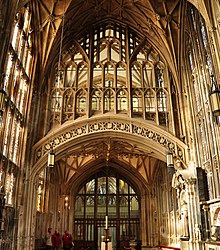
I love Gothic architecture in general and the several first entries will be my favorite sub-styles of it. I love the the way Gothic Cathedrals try and so often succeed to feel like forests. I love how the structural elements are used to create the aesthetic. I love the organic visual elements. I love that it's such a unique style in Western architecture. And I love the amazing craftsmanship that went into it.
I'm particularly a fan of English Gothic because of it's insanely beautiful and complex ribbed vaults. From English Gothic my favorite though is the Perpendicular style, which was basically the English late Gothic. It's characteristics can be seen in the second pic. It has the stretched arch and the very flowing and organic traceries. I do include here the rest of English Gothic too, since even though the Perpendicular style is my favorite of them, all if it is still one of my Gothic favorites.
German Late Gothic
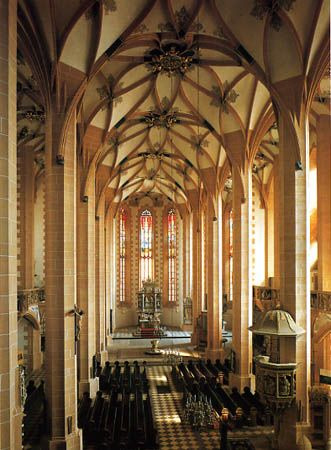

As it's becoming clear I love Late Gothic architecture in general the most, and in the geographical axis I also love German Gothic. Early and High Gothic were mainly divided into French and English styles and the French style dominated in the continent, just being altered a little to the local building traditions outside of France, but during late Gothic it diverged much more strongly into different styles.
German Gothic also has beautiful complex faulting (though less insane than English) and it also has that same pursuit of massive height French Gothic has. Those combined with that Late Gothic's more streamlined flowing and organic aesthetic, some of the German Late Gothic cathedrals really sell that feeling of standing in a forest.
Finnish "Gothic"

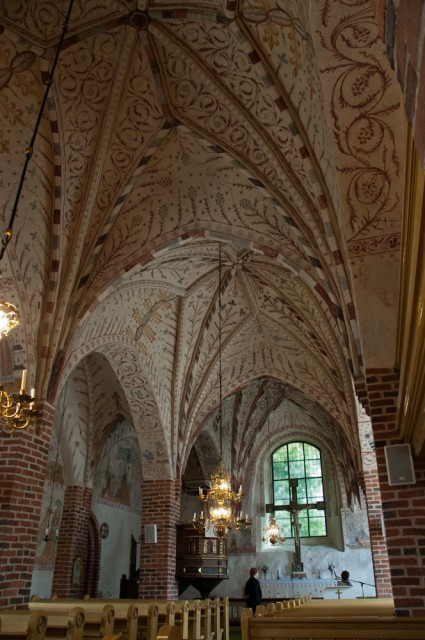
I have a soft spot for the Finnish Medieval stone churches, which are not nearly as sophisticated or detailed as the other European counterparts, but still made with beautiful craftsmanship and they have some cool own features. It's very far from the European Gothic traditions, as you can see, but that's still the influence, hence Gothic in scare quotes. I love the simple outward appearance with the exposed thick stone walls, the details of the gable that worked as the calling card for the building master and the very steep roof. Like everywhere at the time, the roof in these has wooden structure, which is frankly super cool. It was not a simple engineering problem to make a roof that steep and massive at the time, but the structure works so well there's 600 year old roofs with the original logs still working perfectly well. I also really love the original medieval murals in them, which were painted over during the Reformation (you can't have color in a Lutheran church damn it), but thankfully some of them have been restored from under the paint.
Finnish "Renaissance" Log Churches


Renaissance also didn't land in Finland similarly as it did rest of the Europe. When Renaissance was going on in Europe, they still were building those "Gothic" churches here. These log churches were based on Scandinavian version of the Renaissance church, but they didn't really look like Renaissance churches, and were kinda it's own thing continuing a lot of the aesthetics from those Gothic churches. This is a highly specific style, but I just think they are so cool and pretty? Like they really made a CUPOLA out of log.
Arts and Crafts Movement


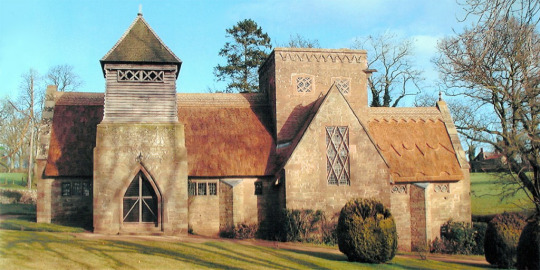
Arts and Crafts Movement didn't have exactly a style, rather a design philosophy that was more important than specific style. There's of course a lot of stylistic similarities in the works of the different members of the Movement, because they had overlapping sources of inspiration and were influenced by each other, so we can think of it as a style. I could, have and will talk about them for hours, but briefly now: It was a moment in latter half of the 19th century and early 20th century and their goals were reviving craftsmanship skills and professions, socialism, opposing industrialism and abolishing the hierarchy between fine arts and applied arts. They were very much influenced by Medievalism and Gothic art and architecture, though unlike Gothic Revivalist, they took more from the guiding principles than the aesthetics. They basically started Modernism and lay ground to all the Modernist architecture's main principles, like form follows function.
Art Nouveau


Art Nouveau was directly influenced by the Arts and Crafts Movement and was the first mainstream Modernist style. I especially love the more toned down Finnish Art Nouveau, or Jugend as it's called here, but I do love the style more broadly too. I'm not that into those almost Baroque style versions of it though, with barely any straight lines. I love the round doors, the stylized floral patterns and the use of light.
Organic architecture
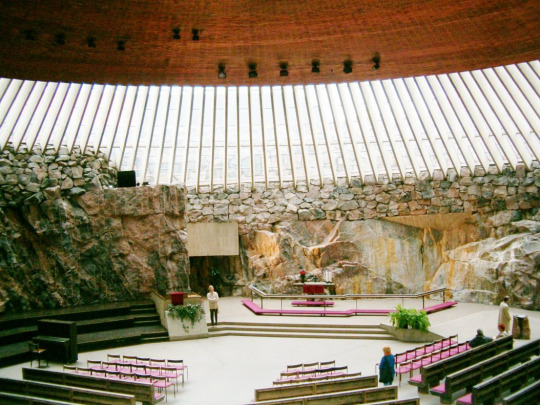


This has to be my favorite modernist/post-modernist (?) style. It's direct successor of Arts and Crafts movement and it's also more of a design principle than a unified style. There is some stylistic similarities, but it is stylistically very diverse philosophy. It was most prominent during the 20th century, but it always stayed in the sidelines, though there are still architects who might be considered practicing organic architecture. Organic architecture is all about living in harmony with nature, taking inspiration from it, designing the building to fit the building spot and the surroundings, extra care taken in to preserve the nature already there, and using local natural materials when possible. My favorite architects are Raili and Reima Pietilä, who were most prominent organic architects in Finland. (I almost moved into apartment designed by them, but it was in pretty bad condition, so it wouldn't have unfortunately been worth the price.)
Brutalism


I know it's not for everyone and it's not easy to make it work but when it works, it really does. It was born in 1950s during the reconstruction era. Brutalism is not just concrete though. The point is to show the raw materials and the structural elements. Technically a lot of Gothic and Arts and Crafts architecture is then brutalist. Timber frame architecture? Also brutalist. I'm only half joking, of course the style itself is also very bare and, well, brutal, but I love it for the same reasons. I really love bare textures of materials and exposing the materials of the structural elements. And I do actually really like the texture of concrete. Though I will say concrete is destroying our world and we should use it as little as possible. But we should also protect old buildings and keep using them rather than built new ones, so I feel fine admiring the old brutalist buildings. The best brutalist buildings combine materials very intentionally and make works of art with the light.
Bonus - Favorite contemporary architecture: Traditional methods



As we're living in the post-modern times, there's not really unified and specifiable styles or architectural ideologies anymore. They all kinda flow into each other and architects don't organize themselves into clear groups based on style and design philosophy. So it's hard to put into words the style I like in contemporary architecture. There's been growing interest in studying traditional structures and methods, learn from their sustainability and incorporate them into contemporary architecture. They are techniques that have been developed through trial and error on the span of centuries, so we really don't have to reinvent the wheel here. Traditional methods of a given area have also been developed for that area and it's climate, from the materials available there, so they also push us to use local materials. Typically these traditional structures are very simple, often made from solid material, which makes them easier to built without construction error (a huge problem in modern structures), and easier to fix and maintain, when inevitably there is issues. Also they are beautiful, definitely more so that steel and glass. I love solid brick structures, log structures, timber frames, natural stone, rammed earth and all of them, especially when these beautiful materials are left bare.
#architecture#architectural history#historical architecture#history#art history#modern architecture#gothic architecture#brutalism#arts and crafts movement#art nouveau
549 notes
·
View notes
Text
✦Call of Duty Bio Headcanons✦
(I know they have canon ages and heights and stuff, but listen. It's fiction, and I think I know better(/j). You can disagree, but these are my opinions. Also, obviously, not all of the info has changed.)
✧John Price✧
Age: 42 y.o Height: 6'2" Pronouns: He/Him Sexuality: "Sexy-Is-Sexy" (Or Pansexual) Middle Name: Samuel Likes: Whiskey, vintage radios, old westerns, horses, & mint ice cream. Dislikes: Streaming services, cigarettes(ironic), spicy food, dust, & cottage cheese. Birthday: January 1st Zodiac: Capricorn -Trivia- -Allergic to cats and didn't know until he moved out because his mother had like, four. Grew up around them his entire childhood and was honestly devastated when he realized they make him sick cause he loves'em. -He was definitely a fuck boy in high school/college. Not an asshole one, he made his intentions up front and he was overall sweet, but he didn't wanna be tied down. Ironic given how he ended up wanting the exact opposite later on. -Wishes he took better care of his teeth as a kid. They look great now but he has five fillings in his molars and one (now replaced), silver tooth all the way in the back. Phobia: Amenisphobia; The fear of amnesia Neuro...: Neurotypical
✧Kyle "Gaz" Garrick✧
Age: 26 y.o Height: 6'0" Pronouns: He/Him (I heavily support the trans!Gaz HC) Sexuality: Bisexual w/ a male preference Middle Name: Dylin Likes: Hot chocolate, the smell of lavender, coconut, licorice toffee, & nostalgic music. Dislikes: Milk, politics(irony again), Winter, grocery shopping, & spiders. Birthday: September 5th Zodiac: Virgo -Trivia- -Second oldest of four children, the only boy. He's a family man when it comes to his siblings, but not so much when it comes to his parents. Barely present father and a stressed out mother create for a shaky relationship with them. -Cannot cook to save his life. Man lives off of delivery, MREs, and cup noodles. He knows like...four dishes, and most of them are really simple. -Struggles decorating and making outfits cause he likes tons of different aesthetics. Everything from Scene Kid(for his inner teen) to streetwear. His version of housed decor are a bunch of plants. (Fake so they don't die when he's on deployment) Phobia: Arachnophobia; fear of arachnids/spiders. Neuro...: Neurodivergent (Dyslexia)
✧Johnny "Soap" MacTavish✧
Age: 29 y.o Height: 5'8" Pronouns: He/Him Sexuality: Omnisexual Middle Name: Neil (heh) Likes: Knickknacks, loud music, punk aesthetic, chickens, & football(aka Soccer for us pathetic Americans). Dislikes: Silence, sitting still, vague answers, being told what to do, & big dogs. Birthday: August 12th Zodiac: Leo -Trivia- -Constantly on & off with a caffeine addiction. He'll do really good about just drinking water, then he'll have one energy drink and he's fucked it all up again. -The scar on his chin is from a dog, the scar in his eyebrow is from a fight he got in as a teenager. He got in a lot of trouble as a teen. -Borderline pyromaniac, honestly. Hyperfixated on fire as a kid and now he's really happy to be a bombtech. Bro loves blowing shit up. Phobia: Cynophobia; fear of dogs. Neuro...: Neurodivergent (ADHD, hyperlexia)
✧Simon "Ghost" Riley✧
Age: 36 y.o Height: 6'4" Pronouns: He/It (Using "it" makes him seem more ominous, which he thinks is fun) Sexuality: Gay or Homoflexible, demisexual/demiromantic probably Middle Name: Achilles Likes: Birds, alternative indie music, dark chocolate, Victorian architecture, & murder mystery books. Dislikes: Snakes, graveyards, the dark(when it's completely pitch black), 99% of physical touch, & fluorescent lights. Birthday: December 30th Zodiac: Capricorn -Trivia- -He'll never admit it but he loves babies. They're super tiny and super cute, and Simon's heart always melts when one's around. Alas, he's also terrified of scaring them or getting attached, so he avoids babies as best he can. Can't have people thinking he's soft. -Makes the best steak in Manchester. Sometimes his seasoning is bland but the meat itself is perfection, you won't find any better. Melts in your mouth every time. It's a steak equivalent of 6 orgasms. It IS an orgasm. He makes great fucking steak. -Isn't fond of pure silence like Soap, but he doesn't often wanna fill it with loud sounds. He has a playlist of softer, more instrumental songs for this. Or he'll listen to nature sounds. He likes quiet, just not silent. Phobia: Taphephobia; the fear of being buried alive. Neuro...: Neurodivergent (Autistic, dyscalculia)
✧Alejandro Vargas✧
Age: 38 y.o Height: 5'11" Pronouns: He/Him Sexuality: Bisexual (Maybe Poly? He's not sure) Middle Name: N/A Likes: Hot drinks, the smell of roses, his nieces/nephews, physical affection, & cowboy hats. Dislikes: Sweaty palms, tourist-y Americans, caramel sauce, white-lies, & the feeling of glue. Birthday: March 25th Zodiac: Aries -Trivia- -Was with Valeria for awhile, but differences, stress, and Valeria discovering she was pretty gay broke them up. They had some tension, but he wasn't bitter towards her. Until she betrayed them, of course. -Was actually the last of his friend group to lose his virginity. He's a passionate, flirty man, but he's not throwing that kind of trust out willy-nilly. He had a few relationships but didn't reach that point until he was like, 19, about to turn 20. He asked a friend to share the moment with him. ...a close friend. -Cannot function in the cold at all. And his definition of cold is 21 degrees Celsius. (70 Fahrenheit for us Americans) He layers and complains all day, he's got a fuckin' heated blanket. A heated blanket owner in fucking MEXICO. Phobia: Coulrophobia; the fear of clowns Neuro...: Neurotypical
✧Rodolfo "Rudy" Parra✧
Age: 38 y.o Height: 5'9" Pronouns: He/Him Sexuality: Bisexual (Also maybe poly but he's very hesitant about it) Middle Name: N/A Likes: Ice baths, windchimes, baked sweets(mostly pie), clean handwriting, & naps on the couch. Dislikes: Cutting onions, heavy blankets, confrontation(with like, loved ones. Not on duty, obviously), slow walkers, & reptiles. Birthday: June 20th Zodiac: Gemini -Trivia- -Super good at singing, but he never does, because he's embarrassed. His mother would often encourage him to sing when he was younger at family gatherings, and now he cringes when someone hears him sing and comments on it. -His house is full of fans. Some rooms have more than one. They're running basically all the time, as well as the AC. Sometimes he has to get a family member to go home and turn them off when he's on a long mission. -He knew Alejandro before Alejandro knew him. When they were kids, Rudy was shy and had some problems with his health(exercise induced asthma mostly), so he didn't go out of his way to befriend other kids much. But he was a people watcher, and Alejandro was the most fun to watch. They actually met because one of Alejandro's friends pointed it out and called him creepy, only for Alejandro to defend him. Then they became super close friends! Phobia: Bufonophobia; the fear of toads Neuro...: Neurodivergent (Autistic, echolalia)
✧Valeria Garza✧
Age: 39 y.o Height: 5'7" Pronouns: She/It Sexuality: Sapphic Demiromantic Middle Name: N/A Likes: Expensive paintings, perfect nail-polish, sandalwood incense, lemon water, & flowers. Dislikes: Shaving, back-talk, tiny text on documents or books, chunky rings, & pineapple. Birthday: January 23rd Zodiac: Aquarius -Trivia- -Has a pull to religious imagery in a darker light because of religious trauma. Roman Catholicism is quite common in Mexico, but her parents were really heavy about it. To the point it makes Valeria bitter over it. She has a rocky relationship with God, but finds Mary comforting. Because when she was brought to church, but wanted to hide, she'd hide beside a Mary statue in a corner. -She has an odd sleep schedule. She often only gets four hours of sleep, but she doesn't seem to be tired at any point. In fact, the more sleep she gets, the more lethargic she is that day. -Her first girlfriend was when she was still in the military. A traveling medic from Italy. Unfortunately, the flame came and went thanks to the medic having to leave. Valeria has moved on, but she does mourn their lost time sometimes and has a little dream of meeting her again one day. Though she knows that's not practical. Phobia: Ecclesiophobia; the fear of church Neuro...: Neurotypical
✧Alex Keller✧
Age: 36 y.o Height: 6'1" Pronouns: He/Him Sexuality: Heteroflexible Middle Name: Sebastian (he's embarrassed about this) Likes: Golden retrievers, bad jokes, most seafood, provolone cheese, & hummus. Dislikes: Thanksgiving, the sound of rubbing styrofoam, being told to "do what he wants"(makes him feel aimless), tobacco smell, & overzealousness. (He likes simplicity...excluding his tattoos) Birthday: December 2nd Zodiac: Sagittarius -Trivia- -He doesn't really talk to his family excluding holidays. BUT, he will always keep in contact with his older sister, and his niece by proxy. They're the only two that made him feel wanted in his family. He wasn't abused in his mind, but he wasn't paid attention to much either. He always seemed overshadowed by something/someone, and as he got older, he got tired of feeling like an outcast in his own family. So he slowly drifted away and he goes on the guidance of orders he receives. -Probably born in a small town in a place like Utah. He's got small-town-mid-south manners. But I like to imagine he spent a lot of his time in California too, he seems like he'd enjoy the sun and the ocean. -Picks up languages really quick, somehow. At least, when he's around people that speak it. If he had to learn purely from books, he'd have choppy speech at best. He's fluent in English, Spanish, and Arabic. Also, knows a bit of ASL, but he's still working on that one. Phobia: Lilapsophobia; the fear of hurricanes/tornadoes Neuro...: Neurodivergent (Hyperlexia, SPD)
✧Farah Ahmed Karim✧
Age: 30 y.o Height: 5'5" Pronouns: She/Her Sexuality: Aliquaromantic Demi-Bisexual Middle Name: N/A Likes: Poppies, motorcycles, pretty much any food with chickpeas, super spicy stuff, and the sky at dusk. Dislikes: Overly salty things, riddles, genuine cockiness, the feeling of rust(that includes on spoons...), & long winded responses. Birthday: July 1st Zodiac: Cancer -Trivia- -Keeps her hair long despite the fact it's annoying to deal with sometimes. Purely for sentimental reasons. To her, it represents the growth she's had as a person. A far cry from the buzz-cut she was forced into when under someone else's control. So she refuses to cut it. -She will never use it, and she despises it, but she's semi-fluent in Russian. Being around it for so long made her pick it up. It works well if she needs to translate, but she'll be caught dead before she speaks Russian. -Honestly can't cook for shit. She doesn't know what the hell she's doing in the kitchen and basically relies on MREs or the skills of others. She's not a picky eater though, and she'll always finish what's put in front of her, even if she's not fond of it. Phobia: Agniophobia; fear of choking Neuro...: Neurotypical
✧Konig✧
Age: 28 y.o Height: 6'10" Pronouns: He/They Sexuality: Bisexual Middle Name: Obercht (Bonus)Last Name: Badubrecht Likes: Making bracelets, boxing(watching or doing), soda, heavy metal, & fresh bread. Dislikes: Certain kinds of wool, small cars, low doorframes, having to go to the medic, & the smell of hay. Birthday: March 9th Zodiac: Pisces -Trivia- -Was bullied all through high school for various things. His demeanor, his size, his hair(which was long), his cleft lip scar, etc. It took until he hit the largest growth spurt he ever had in secondary school when people began to stop poking fun, but instead avoid him. He maybe had 2-3 actual friends in his entire life before the military. And even now he mostly has acquaintances, not friends. -Doesn't talk to his mother, she was overbearing and cruel, mostly because Konig looks a lot like his father. He doesn't really talk to his father much because the man is hard to talk to. He's not completely cut off, but they are estranged. Konig's grandma hears from him almost every day, sometimes twice a day. She's a badass in her 90s who has never done him wrong, and he would blow up the entire world if anything happened to her. -Sometimes Konig gets comments that say he's got multiple personalities. (By uneducated people, clearly) Because he seems to switch dramatically between modes depending on time, place, and circumstance. Sometimes he's childish and giggly, cute even. Sometimes he's silent, unreadable, and withdrawn. And on the battlefield he's...inhuman, terrifying, and nothing short of bloodthirsty. Phobia: Equinophobia; the fear of horses. Neuro...: Neurodivergent (autistic)
#call of duty#call of duty mwii#modern warfare#captain john price#john price#john soap mactavish#soap mactavish#simon ghost riley#konig call of duty#farah karim#alex keller#alejandro vargas#rodolfo rudy parra#valeria el sin nombre garza#kyle gaz garrick#gaz mw2#soap x gaz#headcanons#call of duty headcanons
279 notes
·
View notes